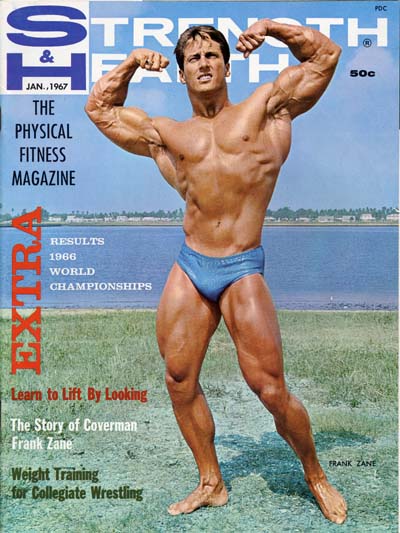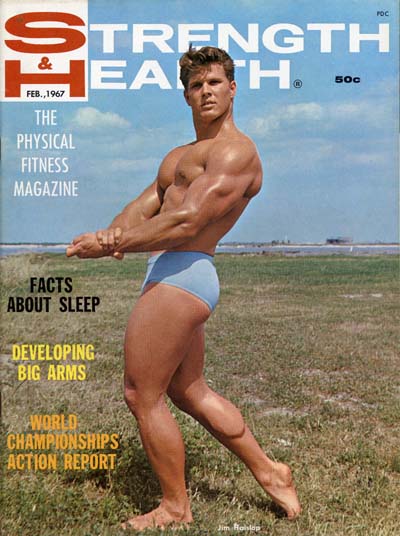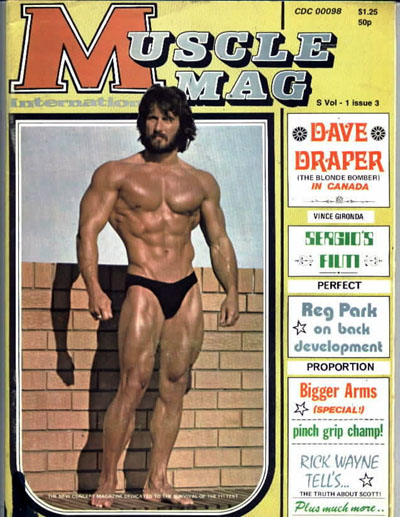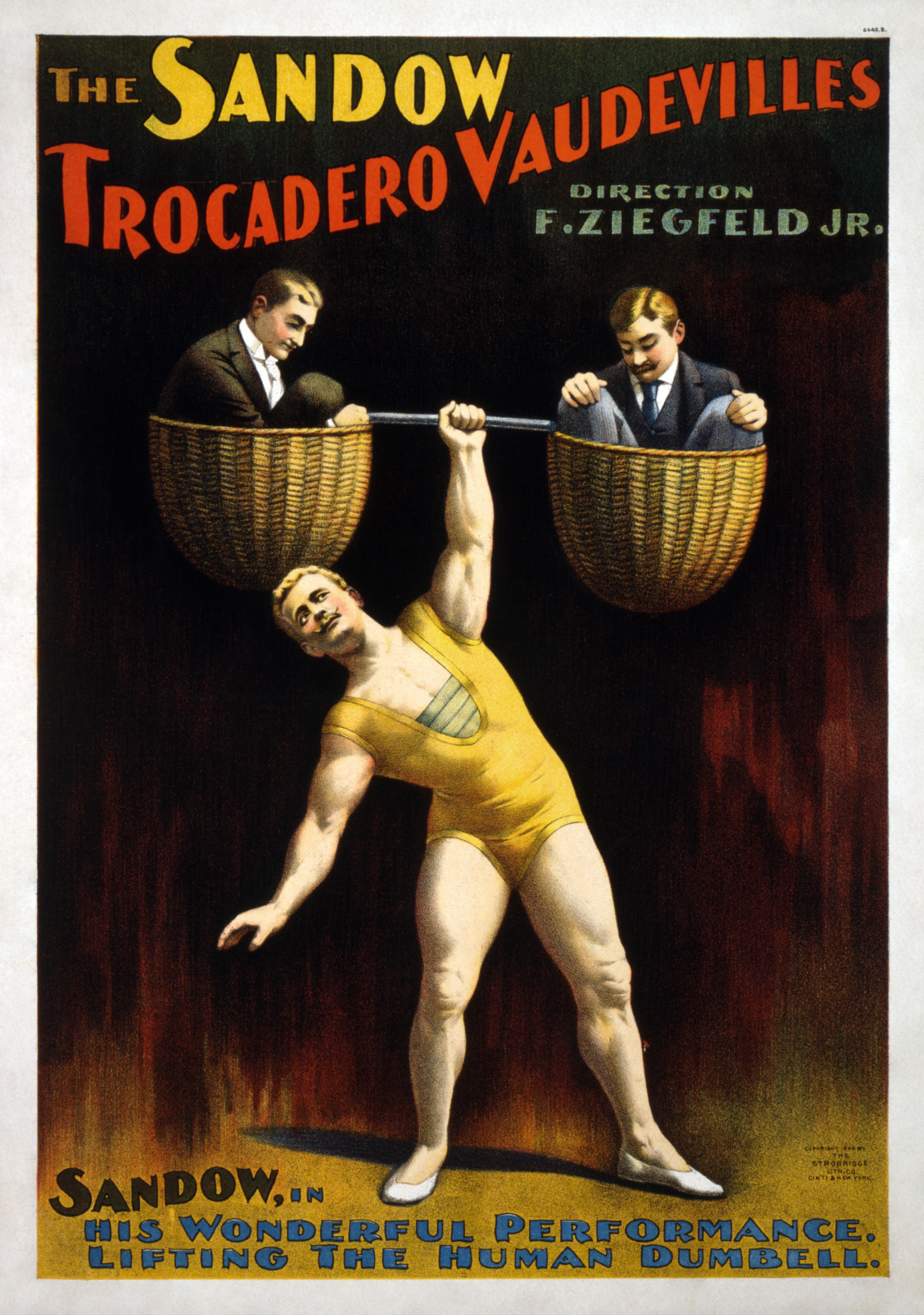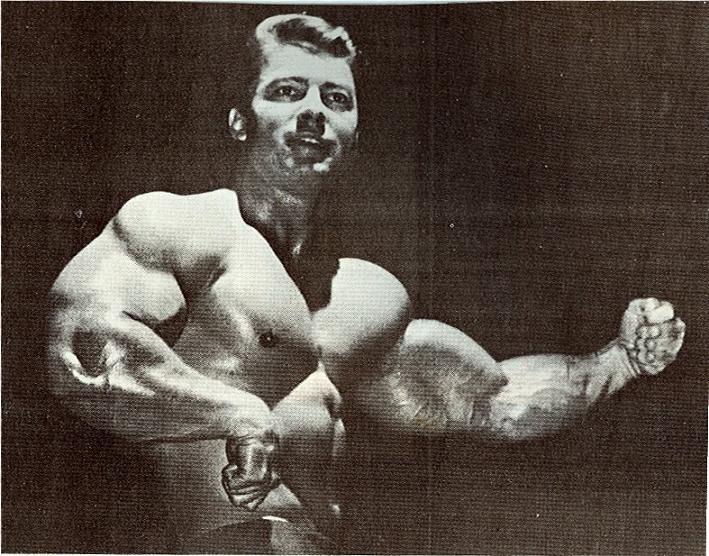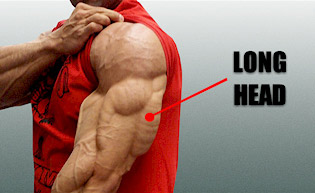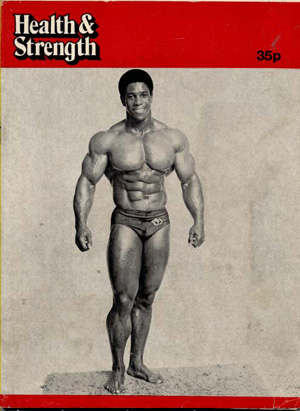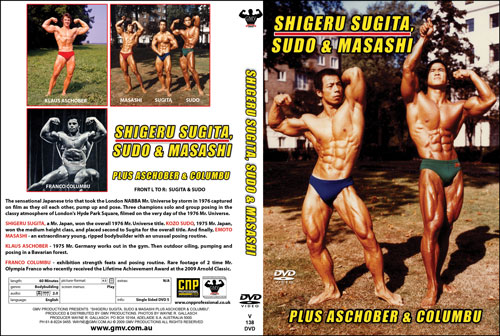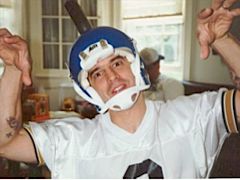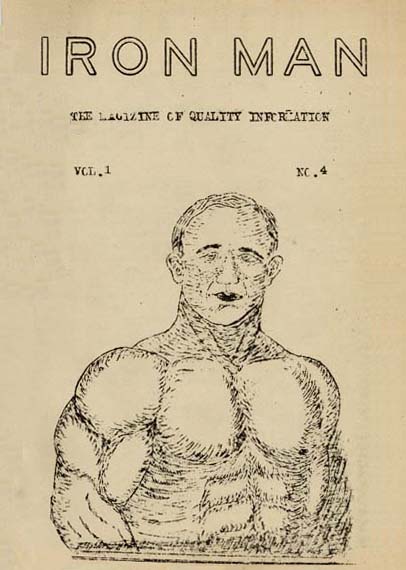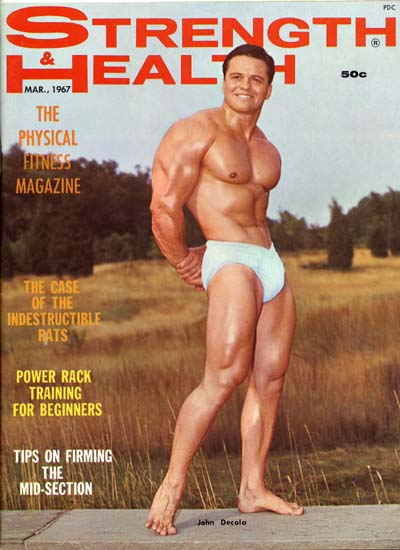Check into Joe Roark's Iron History Forum!
Megatons of Information Over There.
Note: Your Real Name will be required for access.
Bernarr MacFadden
by David Pirie Webster (1975)
From This Issue
August 1975, Volume 1, Issue 3
Online Archive of Macfadden's "Physical Culture" Magazine:
http://libx.bsu.edu/cdm/search/collection/PhyCul
In the world of weights there have been many larger than life characters, many eccentrics but just a few clever enough to become millionaires. Bernarr Macfadden was all of these. "Crazy", Whacky", "Hole in the Head", "Screwball". There were just a few of the adjectives used to describe this weird and wonderful personality, but he made millions of dollars and when 80 years old he was the owner of a chain of magazines and newspapers, a string of hotels, health farms and schools, he was worth not less than $30,000,000 - that was equivalent to $100,000,000 at this present time. [That's edging close to 500 million in the 2017 equivalent.]
It is hard to pinpoint the start of his rise to success because there were many significant milestones along the way. The physical culture millionaire started life as the delicate son of an alcoholic father and consumptive mother. The family was very poor and when the boy was four his father died of delirium tremens. Not long after this, tuberculosis got the better of his mother and Bernard Adolphus Macfadden, as he was christened, was left all alone in the world without a penny to his name.
In later years he vividly recalled how he overheard his foster parents saying that "consumption" would likely prevent him from reaching adulthood, and being a very sickly youngster it seemed as if their prediction would come true. Bernarr Macfadden, as he became known in later years, had, however, a curious knack of overcoming handicaps and the first turning point came when he was sent to work on a farm at only 11 years of age.
He thrived on the hard work and outdoor life and soon began to feel very grown up. So adult did he feel that he decided to copy his elders and get a skinful of liquor and a big cigar! The resulting nausea made him swear that he would never again in his life indulge in these so called luxuries, indeed until the end of his days he vigorously discouraged all forms of smoking and drinking. This was Macfadden in a nutshell - a man who did nothing by halves. He had an almost fanatical approach to everything he tackled. Sometimes he 'came a cropper' but always he came up for more and made progress along the way.
As a boy he always had to go barefoot and when he was jeered at for being permanently unshod he asked his foster mother to buy him a pair of shoes for Sundays. When this was refused he realized that if he were to have the things he wanted he would have to become completely independent. He was prepared to work hard to achieve these aims and these independent and hardworking traits were yet other characteristics demonstrated throughout his life. As can be expected with someone of this temperament he tended to work too hard. He developed a hacking cough and lost the vitality which he had gained working on the farm. Medicines seemed to have no effect whatsoever so he decided to join a gymnasium. His thinking in this line was influenced by the Police Gazette, a paper which did a lot to popularize activities such as weightlifting, wrestling and boxing.
Unfortunately because of the rather staid and conservative attitudes of that period, the Police Gazette was considered "not altogether nice" and was not taken very seriously by most people. However, there were many young folks like Macfadden who were inspired and when he went along to the St. Louis Gym, hosed at that time in an old church, he was astounded at the physiques he saw. Even the very worst of those present was a lot better than he was. Macfadden the bodybuilder was born that night.
The fees for the gym were too much for him to pay, he only got $6 per week, but he got a set of dumbbells and worked until he ached. He even took to carrying weights with him wherever he went and people stopped saying he was dying - instead they said he was going mad AND PEOPLE KEPT SAYING THAT UNTIL THE DAY HE DIED!
His early working life as varied and interesting. He went to Kansas as a farmhand and took up boxing and wrestling in his spare time. He worked on the railroad amongst the roughest and toughest, often shoulder to shoulder with jail-birds. He hoboed his way across the country, the only tramp on the road who carried his own dumbbells!
His fellow "gentlemen of the road" would watch in amazement as he went through a workout on the freight trains which they jumped in their long hauls across the continent. At another time he worked in a coal mine but a most important step was taken when he got a job as a printer's laborer and went to work on a newspaper. Here he learned a lot about printing and publishing which was invaluable to him in later years. Unfortunately, this newspaper failed and soon he was on the road again.
On a journey back to St. Louis he took stock of himself and tried to assess what he was doing with his life and what he should try to do. Most of all he wanted to have a gym of his own and with this in mind he decided he must settle down for a while and learn all he could. working with terrific enthusiasm he quickly mastered many gymnastic feats on various pieces of apparatus. He could do grand circles forward and backwards on the horizontal bar and dismount with a variety of somersaults. He would sing in his terrible voice as he swung on the bars. Here he was in his element.
Soon he was of professional standing but his work took another turn when he read William Blaikie's well know book on how to get strong.
How to Get Strong and How to Stay So (1879) - by William Blaikie:
https://archive.org/details/howtogetstrongho00blai Instead of pursuing gymnastics Bernarr, still a keen bodybuilder, widened his horizons and became what he termed a 'physical culturist'. He also took up wrestling very seriously and his instructor George Baptiste advised him to turn professional and this he did with some degree of success. He became proficient in several different styles and one of the best books on early American professional wrestling makes special mention of Macfadden.
Even then his reputation as a crank grew to great proportions. He experimented with weird diets and turned more towards vegetarianism.
He took two or three jobs at a time working all day and every day and whenever he could get wrestling matches or jobs in circuses he would take those to supplement his income.
By 1890 he was already making a name for himself. He began to invent equipment not only for bodybuilding but an amazing variety of weird gadgets most of which were rejected by the U.S. Patents Office.
According to one of the wives he had from time to time, some of his inventions made efforts appear completely rational. [Britain’s “Gadget King”—master of the art of creating madcap contraptions that made use of ropes, weights, and pulleys to perform relatively simple tasks, from wart removal to peeling potatoes. Although he trained as a painter and also worked as a book illustrator, Robinson developed his forte with drawings of gadgets that parodied the absurdities of modern life.]
Not all of them were crazy, though. His "Washed Air System" for example, was surely the forerunner of modern air conditioning and one of his wall muscle developers was standard home exercising equipment for almost half a century. Amongst his "way out" and less successful inventions were double decker underground trains, and being rather obsessed with sex he invented a peniscope designed to restore male vitality and potency. [Something of a forerunner to the vacuum pump].
Bernarr Macfadden came to Britain in 1897 at a time when it was exactly right to launch a boom in physical culture and bodybuilding. The inspiration of Sandow and the growing immigration of European strong men had set the scent and a curious chain of events led to the establishment of the worlds first bodybuilding and physical culture magazine. Some say it was 1892, but the bulk of my evidence suggests it was 1897.
Macfadden's Physical CultureHopton Hadley F.I.S.A.C., F.I.S.M.A., was hard at work in the London H.Q. of the British Cycle Corporation when a young American called to sell him a supply of Whitely Exercisers, a wall developer which was virtually unknown in Britain at that time.
Click Pics to ENLARGE
Hadley asked for a demonstration and hinted that if the apparatus was effective then the salesman should, by his own physique, be able to show the results. It was just the sort of chance that the American needed. He stripped off and used the developers, showing his muscles to advantage as he did so. It was the start of an association which made the demonstrator world famous - this salesman was Bernarr Macfadden.
Hadley, a very shrewd businessman, gave Macfadden a large order for the apparatus but made it a condition that the American personally launched the sales campaign by giving exhibitions, while suitably attired, in the large windows of Hadley's cycle shop in Newgate Street, London. It was a sensation! Vast crowds gathered daily and three days later the police issued a summons for obstruction. The boom was on.
One of the first ventures they embarked on, with Hadley's backing, was the publication of a magazine. It was a monthly journal known as Macfadden's Physical Culture.
It was started in a small way but was quite successful.
Macfadden worked in one room writing most of the articles himself under a variety of pen names. He illustrated the features and even did his own printing. Thirsting for independence Macfadden wanted to go his own way and the magazine was taken over by Hopton Hadley on his own. Volume 2 went on the bookstalls re-named Health and Strength, a title which is still synonymous with the bodybuilding movement in Britain.
Macfadden also continued in the publishing field but diversified more than Health and Strength. While the latter continued to specialize in news and information on strength and muscle building, Macfadden turned more to treatment of common ailments and sensational nature cures. "100 pounds for any case of cancer we can't cure" was on of his sensational challenges and he was dedicated to such things as eliminating the wearing of spectacles and corsets.
His magazine "Physical Culture" was published in America but he also had a special British edition printed in London, and, although largely a health and fitness magazine, because of his main personal interest, he chose to call the magazine "Physical Development".
In April, 1902 he started the British edition of Health and Beauty, a magazine for women, which, for some time, met with great success. He had many setbacks in the publishing field as physique pictures of naked men, sporting nothing but appropriately placed fig leaves were considered by many to be obscene, and he claimed that it was for this reason he returned to America to print "Physical Culture" in New York. Even there he ran into trouble and had to flee back to Britain. It all started with his constant demand for sensationalism and he kept going just a little bit further, seeing how far he could go in printing lurid articles.
The crunch came in 1907, when he was arrested for sending obscene material through the post. In actual fact, this was his physical culture magazine with a descriptive warning against venereal disease. He was fined $2,000 but President Taft kept him out of jail and Macfadden remained in Britain until public opinion in America cooled off.
By this time he was a prolific writer and in addition to having produced hundreds of articles and numerous books, he had also written an Encyclopedia of Physical Culture in five volumes and over 3,000 pages.
He was a staunch advocate of bodybuilding but for commercial purposes, he preferred to promote "kinistherapy" as he realized the everyday ailments of the population created a better market for his literature than the interests of specialized muscle men. It is clear that his second visit to Britain allowed him to sell the many books which had to lie unopened after the court action when the bottom dropped out of the American market.
Macfadden toured Britain giving lecture demonstrations, selling his books and setting up physical culture societies. His disciples in cities all over the country plugged his goods and kept the money flowing in. Cashing in on his experience in in physique contests, the wily entrepreneur fan figure competitions for a 100 pound prize. While less than his first big prize for men it was a fortune in those days and the extent of this can only be estimated by considering that it would take many of the entrants four to five years to earn wages totaling that amount. It sounded wonderful for the winners but Bernarr was a real crafty operator. Part of the conditions was that the winning girl in the figure competition would go on tour with him and he withheld the prize until the end of the tour. During this time the winner got living expenses only. To make matters even better for the promoter he married the winner, Mary Williamson, before the tour was complete and persuaded her to invest her prize money and book sales commission into some of his enterprises.
The incredible life of Mary and Bernarr Macfadden is entertainingly told in her book "Dumbbell and Carrot Strips" and I heartily recommend this book to anyone wanting to read of the idiosyncrasies of this eccentric crusader.
It is worth mentioning how I came to get the book. Having heard of this publication years earlier, I considered it to be an essential part of my research for this present review, but it was completely out of print and I just could not get a copy in libraries. I made requests to the libraries to obtain one for me but again drew a blank.
As the time came to write the Macfadden part of one of my books, I had to proceed without it and started taking notes. I was interested to find that like George Hackenschmidt, Macfadden was a great believer in cosmic influences. Being rather skeptical I laughed at this and commented that anyone as publicity conscious as Macfadden would have given me some cosmic guidance to assist me in my work. Then things began to happen. A letter from John Valentine, "The Michigan Hercules", told me of an Australian, Sydney Hurst, who had a collection of bodybuilding books for sale. I found that he had listed the coveted book "Dumbbells and Carrot Strips" but unfortunately it had been struck off the list as being sold. Undaunted, I wrote asking the name and address of the person who had bought it, as I would try to make contact. After writing the letter, I had to travel to London for a film preview and at the reception chatted with Tom McNab, the National Athletics Coach. He told me that he had bought some books recently from an Australian, Sydney Hurst, and one of these, "Dumbbells and Carrot Strips", might interest me. I was astounded. He did not know anything at all about my search and out of the 8,000,000 people living in London, 400 miles from my hometown in Scotland, I had to pick the one man with the book from the Australian mentioned to me by the American. Would anyone like to guess the odds against such a thing happening.
There was an interesting sequel. Tom sent the book to me without delay but didn't enclose his name or address with the parcel. IN THE VERY NEXT MAIL I GOT A LETTER FROM SYDNEY HURST TELLING ME THAT HE HAD SOLD THE BOOK TO MR. McNAB AND THE ADDRESS WAS GIVEN!
Cosmic influences? Such matters can't be discussed in a work of this nature, but I can relate how I came to get the information I needed.
Macfadden's Competitions
In actual fact there were several interesting competitions for muscular development at the turn of the century, and Macfadden, through his magazines, ran a world wide competition which selected area winners going forward to national finals and then finishing up in New York for the world title. Naturally the early rounds were judged photographically and this gave him excellent material for his publications and helped to boost his sales. The standard varied considerably and while there were some outstanding specimens the majority were of a pretty low caliber. The eventual winner was Al Treloar but that is getting a little ahead of the story.
The competitions were announced in 1903 and the February issue of the British edition outlined the basic concept. There was to be a 200 pound prize (equivalent to about eight to 10 years salary of ordinary working people in Britain at that time). In American currency the prize was $1,000. The winner, it was said, need not necessarily be a big man. The prize would be awarded to the BEST AND MOST PERFECTLY DEVELOPED MAN. (Sounds like Muscle Mag's philosophy! Ed.)
"Symmetry, perfect contours, beautiful outlines, a body with all parts superbly developed, are the requirements we call for in the prize winner, but it matters not whether his height is FIVE OR EIGHT FEET." The competition was open to the whole world and the winner was declared The Most Perfectly Developed Man in the World. "A fair field and no favors will be the policy followed," said Macfadden. "We have taken every precaution to ensure that there will be absolutely no element of favoritism or injustice in the competition."
There was also a 200 pound prize for the most perfectly developed woman and the announcement about this carried a back pose of a woman flexing her biceps.
When the conditions of entry were eventually published for the great "Perfect Man" contest it appeared that height did indeed matter. The minimum height was to be 5'4" but there was not weight limit. Every applicant had to be between 20 and 50 years of age and a subscriber to the magazine. Photographs had to be accompanied by measurements. In addition to the 200 pound prize, medals were awarded to the most perfect applicants in the various centers. The winner of each particular center was given return tickets to New York. The notes continued:
"Remember that this competition is not to decide who is the most wonderfully developed man, as we do not desire to select abnormal representatives or freaks from the standpoint of development; we wish the prize to be awarded to the most perfect specimen of physical manhood."
Preliminary rounds were held all over the U.S.A. and in the main towns of Britain. The best from competitions in such places as Liverpool, Manchester, Birmingham, Sheffield, Newcastle, Bristol, Brighton, Edinburgh, Glasgow, Dublin and Belfast went forward to semifinals in London and from there a first class return passage from London to New York, with liberal expenses for a short stay in the States was offered as this semifinal prize.
Macfadden got a lot of excellent material for his magazines from this event and pictures came rolling in from all over the world. One of the first was Secundo de Acha, of Bilbao, Spain, who held the coveted title of "Champion Athlete of Spain". This husky weight lifter was a pupil of the celebrated Professor Jose Zamacois, who until his death (before the announcement of the competition) was known as the strongest man in Spain and Portugal. He was honored by having his name added to the title of the most prominent Spanish Sporting Association at the time, "The Society Gymnastica Zamacois".
The finals were held at Macfadden's Physical Culture Exhibition from December 28th, 1903 to January 2nd, 1904 at Madison Square, the competitors and judges were briefed so:
"The general principles which will be adhered to in selecting the prize winner will be uniform, healthy and wholesome development of each and every limb and muscle, and the relative proportions that they bear to each other."
The winner was Albert Toof Jennings, much better known by his stage name "Al Treloar". Much was made of the fact that his arms, calves and neck were exactly the same measurement. Some writers, however, claimed that Staff Sargent Moss, a British competitor, had the same uniformity and was bigger all round. Unfortunately, Moss was disqualified in a preliminary round owing to being heavily tattooed. The British representative W.E. Clements of Leicester finished fourth, after Carl Victor of St. Louis and Harry Blickman of New York City. Victor and Blickman, like Treloar, were professional strongmen.
Treloar or Jennings was born on May 11th, 1873 in Allegan, Michigan. His father, of Cornish extraction, was a lifter and had a barbell which was cast in England in 1830. When Al first went on the stage he assisted an Austrian juggler named Treloar and naturally adopted the same name. When he became a strongman, with the billing of "The Perfect Man", long before the Macfadden contest, he kept the same stage name and retained it throughout his life until he died on 28th February, 1960 at 86 years of age.
By a strange stroke of fate, in 1893, when he was just 20 years of age, he was booked to appear on the same bill as Sandow in Chicago's Trocadero Theater. There were the inevitable changes in the program and Treloar stayed on as Sandow's assistant in Sandow's Refined Trocadero Vaudeville Company of 1894.
Later in the year Al went to Harvard University and graduated with a B.Sc. in physical education. After graduation he went back on the stage where he was assisted by his wife, known as Edna Tempest. He worked "on the boards" off and on until 1907 when he was engaged as Director of Physical Education to Los Angeles Athletic Club. He stayed at this post, a highly respected member of staff for 42 years. In his early days he trained at Anthony Barkers Gym in New York and was in great demand as an artists model. One of his greatest feats was in posing for an art class in New York when
he stood on his hands for eight minutes. His other great feat was tearing three packs of cards, a stunt he could still do in 1922. Treloar said that the $1,000 prize announced was divided with $500 to himself, $300 for Carl Victor and $200 to Blickman, rather different from what the advertisements would indicate.
"Holes in the Head"The screwy antics of Bernarr Macfadden made him the columnist's dream. The more they wrote the more the physical culturist played up to them.
It started in simple ways by publicity about his fasting and cheap diets of carrots, beans and nuts. Then he advocated sleeping on the floor for correcting back troubles and this made him a laughing stock in many places. In recent years, however, this theory had been vindicated and the most eminent back specialists have recommended wooden bases in the beds of sufferers rather than soft mattresses.
He enjoyed going around nude, but as this wasn't feasible, he settled for walking in his bare feet and right up till the end of his days he walked the 5-6 miles to his offices in New York, shoeless and often carrying a 40-lb. bag of sand - particularly if he thought there was likely to be a press photographer around. He also played tennis as often as possible in his bare feet.
He dressed like a tramp, except on very special occasions and the only hat he ever wore had huge holes cut in it for ventilation. His very long hair would stick out of the holes like straw from the stuffed head of a scarecrow.
Macfadden's daily routine for a long time started by his getting up at 5:30 a.m. and having a workout. He did 25 exercises each day and his favorite was single leg squats, doing countless repetitions with each leg. He would then have breakfast consisting of a raw egg with cottage cheese. His only drinks would be vegetable or fruit juices, particularly carrot or lemon juice. Tea and coffee were strictly forbidden in his household.
He married several times and some of his wives had a very tough time. He absolutely denied them any medical attention and his third wife, Mary, told of terrible suffering because of this. Once when she had pneumonia he treated her by hosing her with cold water. When their first child was only four days old, he began immersing it in ice cold water up to its mouth and nose. When another son had a convulsion due to teething troubles, Macfadden submerged the baby in a hot bath, too hot for his wife's hand.
The baby died. Macfadden had many children but even when his wife was in labor he refused to have a doctor in the house. On more than one occasion the situation was critical, but he stuck to his guns. Indeed, he had to deliver his first son himself and ironically enough this was the one time when he was eventually forced to call in a doctor. He had already had four daughters but this time delivery of the thirteen pound infant was followed by a severe hemorrhage and it was quite clear that there was need for a considerable amount of stitching. Eventually, after a very worrying night and morning, Macfadden agreed to call a doctor providing the stitching was done without an anesthetic and that no drug of any kind be used as pain killers. Poor Mary had to be held down as fifteen stitches were inserted and while she screamed with pain, Macfadden stood by, impassive as ever.
"The Virile Powers of Superb Manhood"
https://selfdefinition.org/celibacy/Bernarr-Macfadden-Virile-Powers-of-Superb-Manhood-scan.pdfhttps://archive.org/search.php?query=bernarr%20macfaddenThis was the title of one of Bernarr Macfadden's best sellers. It went to many editions and by 1903 there were over 135,000 copies sold. It went on selling for many years after that.
Macfadden considered himself an expert in "sexology" - a practicing expert. When he married the winner of one of his "Perfect Figure" contests, she was constantly pregnant for the first four years of their married life. "He had," she said, "a perpetual zest for physical love." Unfortunately he spoiled things by being rather clinical and making copious notes on the subject. He believed that the perfect man should be able to maintain love-making for an hour at a time. In her diary, however, Mary Macfadden wrote, "he had some way to go."
His painstaking research eventually found its way into his books and articles which among other things covered the following subjects: Sex and Stimulation in Courtship; The First Enchanted Night of the Honeymoon; Lovers Techniques; Ia Absence of Maidenhead Proof of the Bride's Previous Defloration; Honeymoon Hazards of the First Night; Wife Decides Bliss in Love's Supreme Climax; Control of the Final Climax; Techniques for Augmenting and Heightening Thrills in the Marital Embrace; Exercises to Increase and Sustain Virility.
Throughout his life Macfadden acted as though sex were one of his own inventions and that he'd better make the most of it before it "went out of fashion". While in his 80's and meeting his ex-wife for business luncheons he would still grope under the table in the same way he did many years before. Another habit he acquired was pinching the bottoms of his female acquaintances. This he protested was to ensure that they wear not wearing bustles which he hated as much as he abhorred the wearing of corsets. His dislike for such "falsies" was heightened by the fact that one of his wrestling colleagues had badly cut his finger on one when exploring the mysteries of femininity. Naturally, Bernarr would explain, the wrestler's intentions were honorable. Only curiosity about bustles prompted the action.
When he got married to Great Britain's Perfect Woman she bought him, as a wedding present, he finest pair of silk pajamas she could find. Macfadden did not appreciate this one little bit. He flung them over the chandelier and there they stayed for some time. They were, according to him, "a sinister invention calculated to thwart the inspirational moment of procreation." He much preferred his nightie.
Full credit must be given to Mary Macfadden for her fascinating and often laughable story of life with this strange millionaire. At first she considered him a rare primitive, touched with genius and whose particular purpose made his idiosyncrasies inevitable. A the years passed, however, and she was subjected to all kinds of trials, her attitude hardened and it is a wonder she lasted as long as she did. She was chosen out of over 500 candidates for the Perfect Woman title and she was a genuine physical culturist who most of the time did not mind having to do hundreds of exercises every day. After all, when she was pregnant, and that was very often, she was allowed to reduce her squatting to to just 100 reps each day and to WALK 15 miles a day instead of trotting that distance.
One of Macfadden's remarkable theories was that he could predetermine the sex of his children, provided a strict timetabling of copulation was followed. After having three daughters he was determined to have a son to carry on his work and his wife Mary gave credit to David H. Reeder, M.D. of La Ports, Indiana as the researcher who introduced them to the possibilities of sex premeditation. Basically it depended on the date of conception in relation to the menstrual cycle. the Macfaddens tried this to their own satisfaction producing three sons in a row.
Click Pics to ENLARGE
As part of his lecture demonstration tours Bernarr Macfadden posed in a cabinet, his body dusted with white powder to make him look more like a marble stature. Now of course the tanning effect to look bronze is much more popular. His lighting was superb and had been carefully studied by Macfadden when he was a roustabout at the Worlds Fair in Chicago in 1893. Florenz Ziegfield presented Sandow during this period. The special lighting not only made him look more muscular, it also made him look taller than his 5'6". The routine commenced with muscle controls and muscular poses of the Roman and Greek eras while his female assistant named the statues. In his lectures he got many people on his side by pointing out the healthy life led by Jesus of Nazareth and his disciples. "They were the early physical culturists," he would say, "they walked hundreds of miles, fasted, had a healthy diet of figs and nuts and wore loose fitting robes."
Macfadden was a close friend of Upton Sinclair and George Bernard Shaw, the latter contributing, free of charge, to Physical Culture magazine. Shaw also attended one of Macfadden's health establishments. He had many such clinics, the first at Brighton. This was taken over by one of his pupils, Stanley Lief, who later opened Champneys, the leading nature cure resort in Europe now being run by Lief's son Peter. In Chicago Macfadden had an International Healthatorium where a Doctorate of Physocultopathy of Kinistherapy could be gained in one year. One could also take a course in Hydrotherapeutics or study to be a Professor of Brain Breathing. On more mundane lines, scholarships were obtained to the Institute of Weight-lifters or Certificates gained as Master Masseurs. I understand that this clinic played an important part in Macfadden's political campaign at a later stage in his career.
He went to Italy, was granted an audience with the Pope, was received and got on very well with Mussolini. Il Duce presented him with the Order of the Crown of Italy and King Victor Emmanuel praised him for his lifelong efforts to make men strong and healthy. After this Macfadden took 50 of Mussolini's handpicked Fascist Brigade to America at his own expense and sent them to the Clinic for special training. He had ambitions to be the first physical culture President of the United States and went to great length to achieve his aims.
When he was 60 he still believed his physique was the epitome of physical development and had a plaster cast made of himself. A statue was molded from this by George Gray Barnard and the Pathe Review made a film of it which was shown in over 4,500 motion picture theaters.He had many well know and talented people working for him at one time or another. Walter Winchell started on his road to fame via Macfadden and Mrs. Franklin D. Roosevelt was brought in to edit one of his magazines. It was his magazine "True Story" which really made his fortune. A novel feature of presentation in this magazine was the posing of live models in romantic situations to illustrate the features instead of the usual drawings. Among those he used as models were Mrs. Sam Goldwyn, Bebe Daniels, Norma Shearer, Jean Arthur and Frederick March.
He went into film work and produced a film called "Zongar" for general distribution.
http://www.tcm.com/tcmdb/title/501319/Zongar/full-synopsis.htmlIt included an unconnected series of shots showing muscle men, acrobatic leaps, daredevil stunts in an airplane, weight lifting and Indian club exercises and the inevitable beauty pursued by a club swinging villain. This was followed by another film called "The Virgin Wife". Much more successful was the filming of some of the features from "True Story". They made a lot of money and Rudolph Valentino went soaring to the top after one of these called "Sinners in Love". (1928)
Ann Hardy (played by Olive Borden) moves to the big city where she falls in love with Huntley Gordon (Ted Wells), but she is heartbroken to learn he is just using her. Directed by George Melford, who also directed "Blood and Sand" and several of Valentino's Sheik films.
Valentino, the great silent movie star, agreed that he got his fantastic sex appeal by following the doctrines of Bernarr Macfadden.
Macfadden did not mellow at all with advancing years. If anything he got even more eccentric. He got married again at 80 and carried his young bride not only over the threshold but up a long drive and across a lawn. He also took up parachute jumping and celebrated his birthdays by jumping from airplanes. On his 84th birthday he parachuted into the River Seine in France.
Video of the jump:
A fine four minute video promoting Mark Adams' book on Macfadden:
Plenty of great photos there.
https://www.bookfinder.com/search/?author=mark+adams&title=mr+america&lang=en&isbn=&new_used=*&destination=us¤cy=USD&mode=basic&st=sr&ac=qrIt didn't kill him though his days were drawing to a close. It was his last big stunt but he had outlived most of those who had laughed at him in years gone by. Bernarr Macfadden was very obviously fanatical in his approach to body building, fitness and health. He had enormous drive and a flair for publicity. Many think his eccentricities gave physical culture a bad name and a wrong image but no one can deny that he did a fantastic amount in promoting contests and his concepts, some good and some bad, added a great deal of color to the scene of might and muscle.

